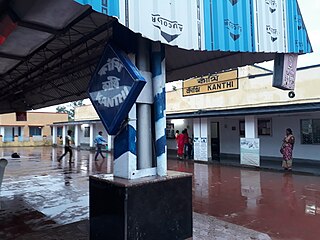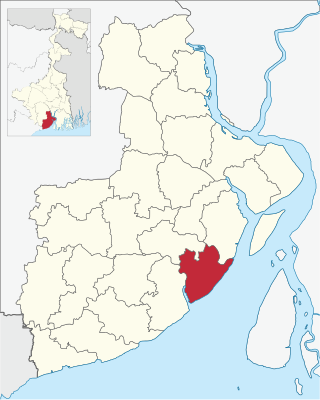
The Indian Institute of Technology Kharagpur is a public institute of technology, research university, and autonomous institute established by the Government of India in Kharagpur, West Bengal. Founded in 1951, the institute is the first of the IITs to be established and is recognised as an Institute of National Importance. In 2019 it was awarded the status of Institute of Eminence by the Government of India. IIT Kharagpur is ranked among the most prestigious academic institutions in India.

Hijli Detention Camp, is a former detention camp operated during the period of British colonial rule in India. Located in Hijli, beside Kharagpur, in the district of Midnapore West, West Bengal, India, it played a significant role in the Indian independence movement of the 19th and 20th centuries.

Kharagpur is a semi-planned urban agglomeration and a major industrial city in the Paschim Medinipur district of West Bengal, India. It is the headquarters of the Kharagpur subdivision and the largest city of the district. It is located 120 km west of Kolkata. Kharagpur holds the oldest and biggest Indian Institute of Technology namely IIT Kharagpur. It has one of the largest railway workshops in India. Kharagpur Junction contains the fourth longest railway platform in the world and is the headquarter of the Kharagpur Division of the South Eastern Railways.

Job Charnock was an English administrator with the East India Company. He is widely regarded by historians as the founder of the city of Calcutta ; however, this view was challenged in court, and in 2003 the Calcutta High Court ruled that he ought not to be regarded as the founder.
Kolkata was a colonial city. The British East India Company developed Calcutta as a village by establishing an artificial riverine port in the 18th century CE. Kolkata was the capital of the British India until 1911, when the capital was relocated to Delhi. Kolkata grew rapidly in the 19th century to become the second most important city of the British Empire after London and was declared as the financial (commercial) capital of the British India. This was accompanied by the fall of a culture that fused Indian philosophies with European tradition.

The history of Bengal is intertwined with the history of the broader Indian subcontinent and the surrounding regions of South Asia and Southeast Asia. It includes modern-day Bangladesh and the Indian states of West Bengal, Tripura and Assam's Karimganj district, located in the eastern part of the Indian subcontinent, at the apex of the Bay of Bengal and dominated by the fertile Ganges delta. The region was known to the ancient Greeks and Romans as Gangaridai, a powerful kingdom whose war elephant forces led the withdrawal of Alexander the Great from India. Some historians have identified Gangaridai with other parts of India. The Ganges and the Brahmaputra rivers act as a geographic marker of the region, but also connects the region to the broader Indian subcontinent. Bengal, at times, has played an important role in the history of the Indian subcontinent.
Hijli is a neighborhood of Kharagpur in the Kharagpur subdivision of the Paschim Medinipur district in the state of West Bengal, India.

Midnapore, or sometimes Medinipur, is a former district in the Indian state of West Bengal, headquartered in Midnapore. On 1 January 2002, the district was bifurcated into two separate districts namely Purba Medinipur and Paschim Medinipur. It was the largest district of West Bengal by area and population at the time of bifurcation.

Nalini Ranjan Sarker was an Indian Industrialist and Statesman, who greatly involved in the economic regeneration of West Bengal. Sarker was Finance Minister of West Bengal in 1948. The Sarker Committee Report was instrumental in the subsequent establishment of the Indian Institutes of Technology (IITs) by the Government of India.
The Indian Institutes of Technology (IITs) are the premier autonomous public technical and research universities located across India, founded under the leadership of Jawaharlal Nehru.

Contai popularly known as Kanthi is a coastal and subdivisional city and a municipality in Purba Medinipur district, West Bengal, India. It is the headquarters of the Contai subdivision.

The Nehru Museum of Science and Technology is a museum in Kharagpur, West Bengal, India. It was founded in 1990 at the Hijli Detention camp building, later the IIT-Kharagpur Heritage Building, which is now named as Hijli Saheed Bhavan. The imposing building, bearing resemblance to the Byzantine style of architecture, was used by the British rulers of India to detain the freedom fighters during the 1930s.

Mirza Abu Talib, better known as Shaista Khan, was a general and the Subahdar of Mughal Bengal, he was maternal uncle to the Mughal Emperor Aurangzeb, he acted as a key figure during his reign, Shaista Khan initially governed the Deccan, where he clashed with the Maratha ruler Shivaji, However, he was most notable for his tenure as the governor of Bengal from 1664 to 1688, Under Shaista Khan's authority, the city of Dhaka and Mughal power in the province attained its greatest heights. His achievements include constructions of notable mosques such as the Sat Gambuj Mosque and masterminding the conquest of Chittagong. Shaista Khan was also responsible for sparking the outbreak of the Anglo-Mughal War with the English East India Company.

The Partition of Midnapore was the administrative breakup of the Midnapore District of West Bengal, India into the western Paschim Medinipur and the eastern Purba Medinipur districts that became effective on 1 January 2002. With a collective population of 97 lakh or 9.7 million, the undivided district was the largest in terms of population in India and more populous than many countries, including Sweden. With the division of the district, the subdivisions of Medinipur Sadar, Kharagpur, Jhargram, and Ghatal were placed in Paschim Medinipur, with Midnapore, now the district headquarters of only the western half. The subdivisions of Tamluk, Contai, and Haldia were placed in the eastern district with district headquarters at Tamluk. Egra subdivision, a new subdivision of Purba Medinipur, was created out of the Contai subdivision.
Mahishya is a Bengali Hindu traditionally agrarian caste, and formed the largest caste in undivided Bengal. Mahisyas were, and still are, extremely diverse caste consisting of all possible classes in terms of material conditions and ranks.

Khejuri II is a Community Development Block that forms an administrative division in Contai subdivision of Purba Medinipur district in the Indian state of West Bengal.

Santosh Kumar Mitra or Santosh Mitra was an activist of the Indian independence movement and a martyr.
On 5 October 1864, most of the areas of Calcutta, India was inundated and destroyed by a tropical cyclone. Dubbed the 1864 Calcutta cyclone, the storm caused over 60,000 fatalities in its wake. The cyclone crossed the coast of West Bengal to the south of Hooghly River, one of the streams that are included in the Ganges River Delta. The majority of the deaths were from drowning and the others from sicknesses prevailing before the storm. The said river overflowed due to a storm surge and as the water rushed inland, everything in its course were washed away. The city, the other surrounding areas, and some harbors had to be rebuilt after the cyclone. There was also a fundraising event established, but it failed. The total damages from the said storm were at Rs 99,200.

Rani Shiromani was the queen of Karnagarh, during the Company rule in India. She was a valiant leader of peasants who rebelled against the British East India Company. she played a major role in the Chuar Rebellion in Midnapore. She created the first revolt against the British through the farmers in Midnapore. She was against the British East India Company and refused to pay taxes.












